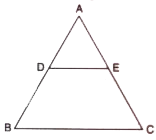In the adjoining figure DE||BC and D divides AB in the ratio 2:3 find.
(i) AEEC (ii) AEAC

Since DE||BC, hence by Thale's theorem.
ADDB=AEEC
Also. ADDB=23
Therefore, from (1) and (2) , ADDB=AEEC=23
(ii) AEAC=AEAE+EC=AE/ECAE/EC+EC/EC=2323+1=⎛⎝2353⎞⎠=25
Topper's Solved these Questions
- TRIANGLES BOOK - NAGEEN PRAKASHAN ENGLISHCHAPTER - TRIANGLES EXERCISE - Problems From NCERT/ Exemplar
14 Videos
- TRIANGLES BOOK - NAGEEN PRAKASHAN ENGLISHCHAPTER - TRIANGLES EXERCISE - Exercise 6a
24 Videos
- STATISTICS BOOK - NAGEEN PRAKASHAN ENGLISHCHAPTER - STATISTICS EXERCISE - Revision Exercise Long Answer Questions
4 Videos
- VOLUME AND SURFACE AREA OF SOLIDSBOOK - NAGEEN PRAKASHAN ENGLISHCHAPTER - VOLUME AND SURFACE AREA OF SOLIDSEXERCISE - Revisions Exercise Long Answer Questions
5 Videos
Similar Questions
In the adjoining figure DE||BC and D divides AB in the ratio 2:3 find.
AEEC

View SolutionIn the adjoining figure, DE//BC and D divides AB in the ratio 2 : 3. Find :

AEEC
View SolutionIn the adjoining figure, DE//BC and D divides AB in the ratio 2 : 3. Find :

AEAC
View SolutionIn the adjoining figure, DE//BC and D divides AB in the ratio 2 : 3. Find DE, if BC = 7.5 cm.

View SolutionIn the following figure, point D divides AB in the ratio 3: 5. Find :

AEAC
View SolutionIn the following figure, point D divides AB in the ratio 3: 5. Find :

AEEC
View SolutionIn the following figure, DE||AC and DC||AP. Prove that : BEEC=BCCP

View SolutionIn the following figure, AE//BC. Find values of x and y.

View SolutionIn the given figure, DE||BC and ADDB=23if AE=3.7 cm , find EC.

View SolutionIn the following figure, point D divides AB in the ratio 3: 5. Find :

Also if :
BC = 4.8 cm, find the length of DE.
View Solution
